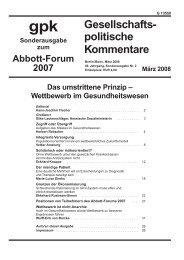Kosten-Nutzen-Bewertung - Leo Schütze Gmbh
Kosten-Nutzen-Bewertung - Leo Schütze Gmbh
Kosten-Nutzen-Bewertung - Leo Schütze Gmbh
Sie wollen auch ein ePaper? Erhöhen Sie die Reichweite Ihrer Titel.
YUMPU macht aus Druck-PDFs automatisch weboptimierte ePaper, die Google liebt.
gpk SONDERAUSGABE GESELLSCHAFTSPOLITISCHE KOMMENTARE Nr. 3/08 – November 2008 – Seite 16<br />
Status quo and trends within the field<br />
of quality adjusted life years<br />
Von Prof. John E. Brazier<br />
John E. Brazier, PhD (Sheffield), MSc (York), BA (Exeter), Professor of Health Economics in the School of Health<br />
and Related Research at the University of Sheffield. He has been a member of a number of commissioning Boards,<br />
including HTA, Trent Health and the MRC HSR Fellowship Panel. He was a member of the National Institute for<br />
Clinical Excellence (NICE) Technology Appraisal Committee from 2000–2004.<br />
Mean discounted utility<br />
Status quo and trends within the<br />
field of quality adjusted life years<br />
John Brazier<br />
Professor of Health Economics<br />
Health Economics and Decision Science<br />
School of Health and Related Research<br />
University of Sheffield<br />
Presentation for the Symposium on Cost-effectiveness<br />
June 17 th 2008, Kaiserin-Friedrich-Stiftung, Berlin, Germany.<br />
Measure of benefit<br />
A new intervention:<br />
• May be less effective and more costly…×<br />
• More effective and less costly….. v<br />
• More effective and more costly….?<br />
• Plus less effective and less costly….?<br />
0.45<br />
0.4<br />
0.35<br />
0.3<br />
0.25<br />
0.2<br />
0.15<br />
0.1<br />
0.05<br />
0<br />
? For resource allocation decisions in health care we<br />
need a measure of benefit that allows comparisons to be<br />
made across treatments and patient groups<br />
Calculating QALY gain of PDT<br />
on Macular Degeneration<br />
0 - 3<br />
3 - 6<br />
6 - 9<br />
9 - 12<br />
12 - 15<br />
15 - 18<br />
18 - 21<br />
21 - 24<br />
24 - 27<br />
27 - 30<br />
31 - 33<br />
33 - 36<br />
36 - 39<br />
39 - 42<br />
42 - 45<br />
45 - 48<br />
48 - 51<br />
51 - 54<br />
54 - 57<br />
57 - 60<br />
60 - 63<br />
63 - 66<br />
66 - 69<br />
69 - 72<br />
72 - 75<br />
75 - 78<br />
78 - 81<br />
81 - 84<br />
84 - 87<br />
87 - 90<br />
90 - 93<br />
93 - 96<br />
96 - 99<br />
99 - 102<br />
102 - 105<br />
105 - 108<br />
108 - 111<br />
111 - 114<br />
114 - 117<br />
117 -<br />
Time in months<br />
Verteporfin<br />
Placebo<br />
The problem<br />
A finite limit to resources<br />
Plus<br />
demands/needs exceed current (or future)<br />
resources<br />
implies the necessity for choice<br />
How should these choices be made?<br />
Calculating QALY gain of PDT<br />
Quality Adjusted Life Years<br />
The Quality Adjusted Life Year (QALY) combines<br />
quality of life and length of life into the single<br />
measure of benefit of a quality adjusted survival<br />
• The ‘Q’ (or utility) is a value assigned to each<br />
health state from zero to one, where zero is for<br />
state equivalent to death and one for full health<br />
Trading off health and life<br />
health<br />
(full health) 1<br />
(death) 0<br />
10<br />
time<br />
Cost effectiveness<br />
New interventions are assessed by NICE and<br />
other agencies around the world in terms of:<br />
• Clinical effectiveness<br />
Assessed using systematic reviews of (largely)<br />
RCT evidence for a range of clinical outcomes –<br />
that increasingly includes quality of life<br />
• Cost-effectiveness<br />
Assessed in terms of the incremental (or extra)<br />
cost per quality adjusted life years (QALYs) over<br />
and above the existing treatment<br />
health<br />
(full health) 1<br />
(death) 0<br />
Quality-adjusted life years<br />
Q<br />
Source: Drummond et al, 1997<br />
The time trade-off<br />
T<br />
10<br />
Q×10 = 1×T<br />
Q = T/10<br />
If T = 6, then Q= 0.6,<br />
and both options<br />
provide 6 QALYs.<br />
time<br />
QALYs = total area





